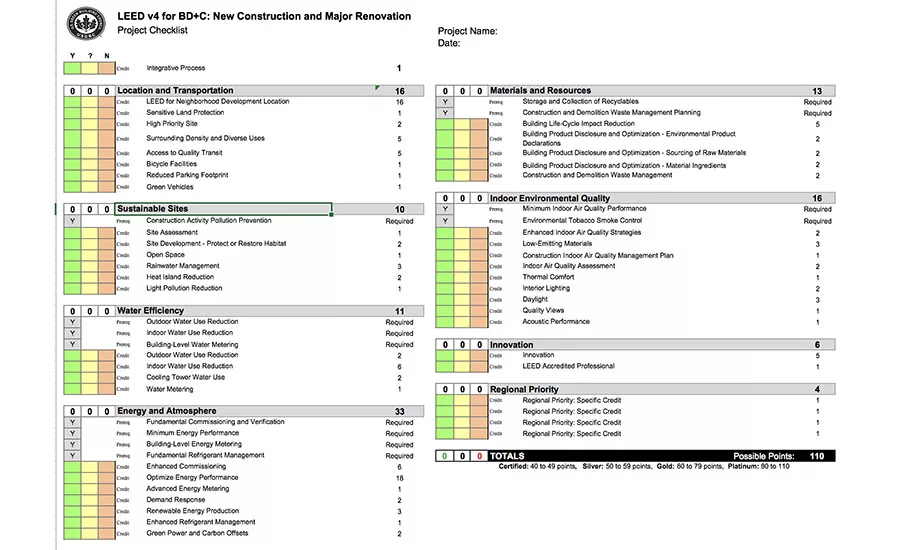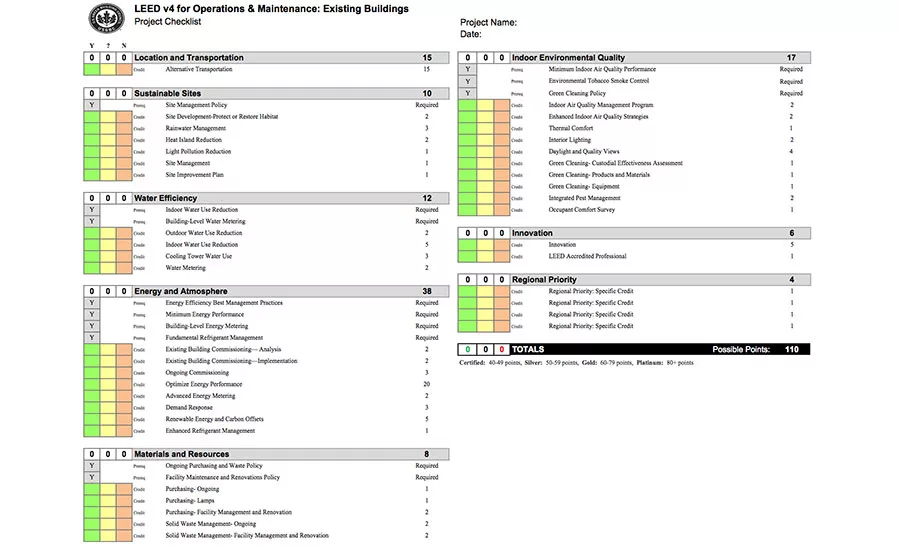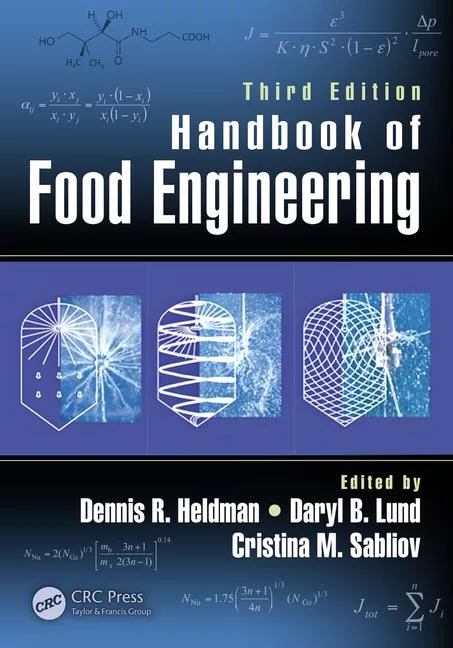Green Series
Lack of specific LEED certification for food processing creates challenges
The lack of a specific program means processors have to carefully determine which LEED certification is right for them.

A rendering of Bimbo Bakeries’ first LEED-certified facility in the United States. As part of the design process, SSOE focused on areas such as process energy recovery and systems monitoring to cut energy consumption.
Photo courtesy of SSOE

A checklist of the points available in new construction projects under LEED.
Photo courtesy of USGBC

A checklist of the points available in existing buildings projects under LEED.
Photo courtesy of USGBC
There’s a LEED for Schools. LEED for Hospitality. Retail. Data Centers. Warehouses & Distribution Centers. Healthcare.
What there is not—at least not yet—is a LEED for Food Manufacturing.
What that means for food processors that want to go green is that there’s no specific program to help guide them through the tricky process of achieving sustainable operations. Without one, food processors have to go through a thorough investigation of what type and level of LEED certification they want to pursue.
That’s not all bad, though. As with any project, a LEED project will have to be customized based on what work needs to be done, how it will be done and where it will be done. Then, there’s the question of what level of certification needs to be achieved.
“Some companies are dedicated to having LEED Gold certification across all their facilities—it’s often part of the company’s philosophy or core values,” says Ryan Danhour, design project manager, Stellar. “But you have to weigh the value of those different certification levels with how much you’re willing or able to spend. For example, a recent project we worked on had a baseline budget of $70 million for the facility and the process equipment. The investment to jump to LEED Silver required an additional $600,000. Achieving LEED Gold required another $1.4 million on top of that.”
As Danhour says, moving up a level requires a big investment. LEED certified is one thing, Silver is another, and Gold is an entirely different animal. Platinum? Possible, but extremely difficult to achieve, especially in an environment that requires huge amounts of baseline energy and water usage.
With all this being said, LEED is still an option for food processors, and a good one at that. Beyond the status that comes from being able to say your facility has been certified, following the guiding principles of LEED will help ensure that your buildings and equipment are being operated in an efficient, sustainable manner. Even if you decide that Gold is too expensive, Silver will still help you see real, tangible results, and the “triple bottom line”—social, environmental and financial—will reflect it.
“It’s a big challenge for food production facilities, but it also provides some great opportunities to really look at your process and how you’re manufacturing your goods or processing your food,” says Jennifer Breault, an architect with SSOE.
Article Index:
- LEED from the front
- New construction
- Possible problems in production
- Existing facilities
- LEEDing to future success
LEED from the front
As with any major project, planning is a critical component of pursuing LEED certification. It will take a lot of time, a lot of money and a lot of buy-in. All of those things can be achieved as long as you build the proper framework for the project before the first piece is put into place.
The three categories that will matter to food processors are Building Design and Construction (BD+C), Interior Design and Construction (ID+C) and Operations and Maintenance (O+M). Generally, BD+C and ID+C will apply to new construction and interior fit-outs, while O+M would be for improvements or projects that require little to no new construction. But a project may be a candidate for either O+M or one of the other categories depending on how much construction is done as part of a renovation project.
While there isn’t a specific rating system for food processors, there is a breakdown of how to achieve goals within the LEED program and how many points each is worth. The total number of points will determine the final rating: certified requires 40-49 points; Silver requires 50-59; Gold is 60-79; and Platinum is 80 or more.
So, step 1 is determining the category, and step 2 is evaluating which level makes sense. Once those pieces are in place, then they can be used to help shape the scope of the project and inform decisions on equipment and operations. While you may have to make adjustments on the fly based on what you find as the project proceeds, nailing down as many of the pieces as possible before work begins will help determine what you will and will not be able to achieve. Regardless of the category and level, keep in mind that there are certain things that are required for LEED certification. For example, any new construction project will have to include building-level energy and water metering.
One important thing to keep in mind is that the boundary of a LEED project can be proposed by the project team as long as it meets the LEED guidelines for defining a boundary. If you are building a new facility, a LEED certification can be pursued for either the entire project or part of the project. If you are overhauling administrative space in a facility that also includes production facilities, you don’t have to try to make existing production equipment work as part of a LEED certification for the administrative space.
“The project boundary for LEED must meet specific requirements,” says Doug Dietrich, program manager of sustainable infrastructure, Burns & McDonnell. “That said, in some cases the way the project team outlines the LEED boundary may differ from actual property boundary lines or how project scopes are defined in contracts with particular parties.”
New construction
A big advantage to new construction projects that are intended for LEED certification is that it opens up a couple of categories for possible points, specifically, “Location and Transportation” and “Sustainable Sites.”
These categories offer a number of points—26 combined—to help build toward LEED certification, and they can be relatively easy to obtain if you have flexibility in your location. Can you locate the facility close to “Quality Transit,” such as bus or train lines? You just earned five points. Can the site qualify for protected or restored habitat? That’s two points, and if you can manage rainwater, you just earned another three.
These categories still may not be viable for a large-scale processing plant, because you might actually need to be away from areas that would offer transportation. But you could still get some points through things such as reducing light pollution and doing a site assessment.
But mixed-use facilities that include office and production spaces may work in a more populated area and open up many of the possible points. Another five-point box that can be checked is “Surrounding Density and Diverse Uses,” which can be as simple as having restaurants or stores nearby that employees could walk to.
Mixed-use facilities also offer a lot of options on how to divide up a project if you’re unsure or unwilling to certify both office and production spaces.
“You can divide the certification almost any way you want,” says Laura Orlich, architect, SSOE. “You could only certify the office and exclude the production facility, as long as you have separations that are clearly defined. Or you can certify the whole thing.”
The office space is relatively easy, because most office spaces offer a lot of opportunities to manage energy usage, environmental air quality and other important aspects that can help earn a lot of points. If everybody who works in the office area is going home at 5:30 p.m., lights can be automatically turned off and HVAC setpoints lowered (or raised). During work hours, natural light and windows that can be opened can help cut down on demands for lighting, heating and cooling. Acoustic panels can help manage the interior sound levels, and indoor air quality can be tightly controlled.
Water usage can also be managed more efficiently. Low-flow toilets and automatic sinks or faucets with aerators can cut water use without creating a hassle for employees. Indoor water use reduction is worth six points on the checklist, so taking some small steps can go a long way.
Possible problems in production
If office space is relatively easy, production space is a different story.
“The tricky part with including the production facility is the amount of energy that it takes to run the equipment,” says Orlich. “Since your energy consumption is very high, it is hard to show an improvement on that to meet the requirements for energy reduction.”
Energy and water are both huge drivers of points for LEED certification. They are also huge needs for food processing plants, and no matter how efficiently you operate, you will have a baseline need for both.
“The big fly in the ointment is that the process loads are always what they’re going to be,” says Matthew Spangler, project architect, Hixson. “As a portion of the entire energy use of the building, the process loads themselves are a huge component.”
Throw in the need to meet quality and safety standards, and it can seem like an insurmountable challenge to reduce water and energy usage. Thankfully, it’s not. By asking the right questions during the design and planning stage, processors can set themselves up to take advantage of opportunities instead of simply responding to challenges.
“Are there opportunities to capture heat and reuse it?” asks Breault. “Are there ways to have some water savings? Is there a way to design that process equipment that would reduce your building footprint? Those are the types of things that, if you can get your team together early and start talking about, then you can come up with some potentially innovative solutions as well.”
In addition to answering those questions, there are a number of different steps processors can take to ensure that they’re operating as efficiently as possible, and they can help you meet your sustainability goals.
The first comes into play in the initial planning process, as you’re asking those questions about your equipment needs and how you can operate efficiently. You know what your production needs are and what equipment you will need. By evaluating available options with an eye on total cost of ownership, you can determine what levels of efficiency you can reach without sacrificing your production and quality goals. Energy-efficient equipment may cost more up front, but less in the long run. While that is a more common consideration now than even five or 10 years ago, it still might require a little bit of a sales pitch, says Jennifer Wondergem, chemical engineer, SSOE.
“A lot of times, decisions get made based on capital instead of operating costs down the road, so there are different things you could choose or design that would possibly be a little bit more expensive on the capital side up front, but would definitely save you energy usage down the road,” she says.
Once equipment is selected, keeping it running properly is another critical component to meeting energy-efficiency targets. Controls and automation play a big role in this, as they can ensure that equipment is doing what it’s supposed to do in the most efficient manner possible. Regular commissioning helps keep equipment in the best condition possible, avoiding potential drop-offs in efficiency that come with equipment that isn’t running at its best.
Water usage also offers some opportunities for efficiency. While you can’t reuse water in every process, you can do so in a number of applications, or you can do something such as reusing process water to make steam. One thing to keep in mind is that LEED allows for water usage to be the same for both the baseline and design values, which means that as long as you’re able to stick to the water usage that your design calls for, you won’t be penalized.
In both water and energy, it is an incontrovertible fact that production is going to use a lot of resources. There are ways to be more efficient in your operations, but you aren’t going to magically cut 75 percent of your energy usage, so that has to be kept in mind.
“The biggest users of water and energy are not usually found in the non-production side of the plant,” says Dietrich. “That really is insignificant compared to the huge process energy and process water loads.”
Existing facilities
As previously mentioned, new construction has some advantages that a renovation project wouldn’t, such as site selection. Still, renovation projects can be worthy of LEED certification; it’s just a different process.
The planning and preparation are much the same, as you still need to identify what you want to do in the space and how you want to do it. And you’re still looking at things such as water and energy usage to determine what you can realistically accomplish.
The biggest difference once you get past the planning stage is having to undertake the project in a facility that already has people in it. New construction projects don’t have to take things such as ongoing production into consideration, but renovation projects certainly do. If you’re going to be engaged in a project while operations are continuing, you have to have a plan in place for that. LEED doesn’t impose any specific requirements for the actual construction process, but any project needs to be managed in a way that it won’t disrupt operations.
“The first step is to develop a site utilization plan—which is essentially a map of the project site and building—and work this plan in conjunction with your schedule,” says Stellar’s Danhour. “Outline which areas will be dirty, which areas will be used to stage materials and equipment and which areas will be active for processing. Then, lay it out in the floorplan to understand where the work will take place and what areas workers need to avoid.”
Blocking off the areas is another key component to avoiding contamination or similar concerns. This can be done with physical barriers, such as airtight and sound-proof walls, as well as by controlling airflow, so there is positive pressure in the production areas and negative pressure in the construction area.
One other possibility is adjusting production schedules in advance of the work, especially in plants that manufacture things such as frozen food, which can be stored longer. You can ramp up production to make up for later shutdowns or schedule shutdowns for holidays or other times when production can be interrupted.
LEEDing to future success
LEED is a challenging process, and it’s supposed to be. The goal is to see real savings in energy and water usage, as well as in other areas that can have a dramatic impact on the environment. That means pushing the limits of what can be done in conserving resources, and that can be a big challenge for food processors that cannot sacrifice quality and safety for LEED points.
But it can be done, and it can be done successfully. If you’re willing to invest the time and money needed to determine how you can operate efficiently and meet the requirements for LEED, then there’s no reason a production facility can’t be LEED certified.
“If you can align all the pieces from the very beginning of a project, then LEED certification is possible for a great many of the food operations that are out there,” says Spangler. “But it has to start from the beginning, and we have to set realistic expectations.”
For more information:
Matthew Spangler, Hixson,
513-241-1230, mspangler@hixson-inc.com
Jennifer Breault, SSOE,
419-255-3830, jbreault@ssoe.com
Jennifer Wondergem, SSOE,
651-726-7660, jwondergem@ssoe.com
Laura Orlich, SSOE,
651-726-7660, lorlich@ssoe.com
Ryan Danhour, Stellar,
904-260-2900, rdanhour@stellarbpo.com
Doug Dietrich, Burns & McDonnell,
913-325-3632, ddietrich@burnsmcd.com
Looking for a reprint of this article?
From high-res PDFs to custom plaques, order your copy today!









